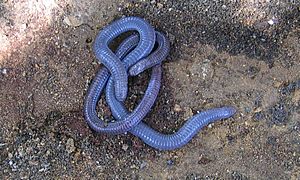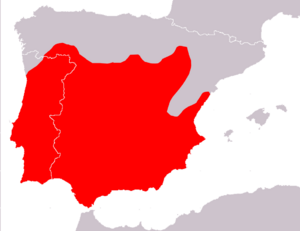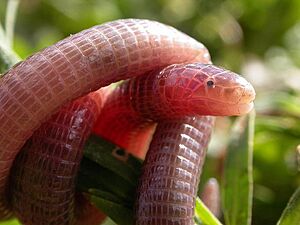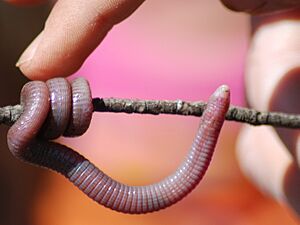Iberian worm lizard facts for kids
Quick facts for kids Iberian worm lizard |
|
|---|---|
 |
|
| Two Iberian worm lizards | |
| Conservation status | |
| Scientific classification | |
| Genus: |
Blanus
|
| Species: |
cinereus
|
 |
|
| Synonyms | |
|
|
The Iberian worm lizard, also known as the Mediterranean worm lizard or European worm lizard (Blanus cinereus), is a type of reptile. It belongs to a special group called Amphisbaenia, which are often called "worm lizards." In places like Portugal and Spain, people call it "blind snake" because it looks like a snake and has very small eyes.
Scientists have studied the DNA of these lizards. They found that there might be two different types of Iberian worm lizards. Even though we don't know everything about them, we are learning more about these ancient reptiles.
Contents
Where the Iberian Worm Lizard Lives
The Iberian worm lizard can be found in Portugal. It also lives across most of central and southern Spain.
Home Sweet Home: The Lizard's Habitat
The Iberian worm lizard lives mostly underground. It can be found in many different types of Mediterranean areas. Because they live hidden underground, it's hard to know exactly how many there are.
These lizards can survive in places from about 400 meters to 1400 meters high. They need to keep their body temperature just right. So, they choose habitats that help them do this.
Their homes usually have lots of rich soil and scattered rocks. The lizards use the loose soil and rocks to control their body temperature. They might move between the top 10 centimeters of soil or under rocks that are 10 to 20 centimeters thick. They go deeper into the soil to cool down. They use rocks to warm up, depending on the time of day. This way, they stay comfortable without using too much energy.
What the Iberian Worm Lizard Eats
The Iberian worm lizard is an opportunistic feeder. This means it eats whatever food it can find easily. At first, people thought they ate only what was under rocks. But studies showed this wasn't always true.
Their main diet is insects and insect larvae (baby insects). These are the most common food sources for them. While they eat what's available, they do prefer larger insect larvae. They also avoid eating certain types of ants. This shows they can pick and choose their food a little bit.
Iberian worm lizards don't need a lot of energy from their food. They might look for rare, energy-rich foods when they can. But they can also easily switch to eating common foods that have less energy.
How the Iberian Worm Lizard Looks
The Iberian worm lizard looks a lot like a worm. It has a body without legs and rings all over it. But unlike worms, it has tiny, undeveloped eyes. It also has small, smooth scales. Most importantly, it's a vertebrate, meaning it has a backbone, lungs, and a closed blood system.
Its head is small and blunt, which helps it dig through soil. Its tiny eyes are covered by skin. The body is ridged and covered in scales, just like its short tail. It has a small, forked tongue. This tongue helps it "smell" and "taste" its surroundings. Inside its mouth, it has small, sharp teeth.
These lizards can be fleshy-pink, violet, or brown. Their color depends on where they live. Adult lizards are usually about 15 centimeters (6 inches) long. But some can grow up to 30 centimeters (12 inches) long. People often mistake them for small snakes or large worms.
How the Iberian Worm Lizard Senses the World
Because Iberian worm lizards live underground, their eyes are very small and simple. They can barely see, only telling the difference between light and dark. But they make up for this by having a great sense of smell and taste. This is called chemosensory signaling.
They use a special organ in their head called the vomeronasal organ. It is very sensitive to chemicals. Scientists can count how many times a lizard flicks its tongue to see how it reacts to different smells.
Finding Food with Smell
Scientists have used cotton swabs with smells of prey on them. The lizards flicked their tongues a lot when they smelled these. But they also flicked their tongues for non-prey smells.
However, when scientists used live prey, the lizards could clearly tell the difference. They flicked their tongues much more for live prey than for things that weren't food. This shows they can tell live food from other things just by their smell.
Detecting Danger with Smell
Studies also looked at how lizards react to smells of predators. They used swabs with smells from snakes, centipedes, and skinks. The lizards flicked their tongues a lot for all three predator smells. They even tried to bite the swabs that smelled like snakes or centipedes. This shows that their sense of smell helps them know when danger is near.
Understanding Their Home with Smell
Iberian worm lizards also use smell to understand their environment. For example, if they smell a predator in a new place, they might be slow to burrow into the soil. But if they are in their familiar home, they burrow much faster.
Male and female lizards also release special chemicals from glands near their tail. These chemicals might help other worm lizards find their way through tunnels.
Recognizing Each Other with Smell
Smell is very important for Iberian worm lizards to tell males from females. The chemicals they release from their glands are different for each sex. Males release a lot of a compound called squalene. Females have a lot of tocopherol in their secretions. Squalene helps males recognize other males. Tocopherol is likely important for females to recognize each other, too.
Family Tree of the Iberian Worm Lizard
We don't know much about where worm lizards, including the Iberian worm lizard, first came from. But studying their DNA has given us some clues. Scientists think that these lizards lost their legs and changed their skull shape over time. This happened in different groups of worm lizards.
DNA studies suggest that legs were lost three separate times in the history of worm lizards. This evidence, along with studying the DNA of B. cinereus, makes some experts believe there are two different groups of Iberian worm lizards. These two groups live in different parts of the Iberian peninsula.
Even though they look very similar, their DNA is quite different. This means they probably don't mix and have babies together very often. Scientists think their underground life might have caused these differences. One group is called B. cinereus and lives in the center of the peninsula. The other proposed group, Blanus mariae, lives in the southwest.




